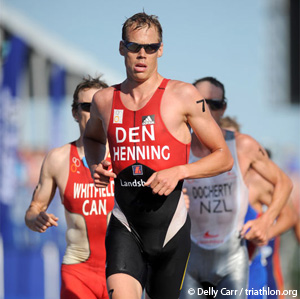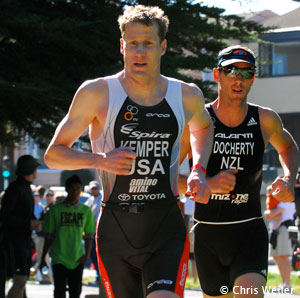The return of Hunter Kemper
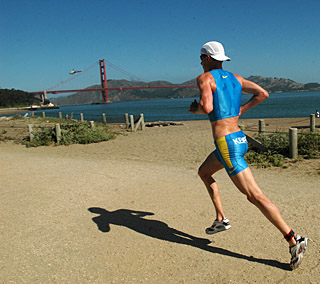
After reaching ITU World Number One ranking in 2005 and starting like a house afire in 2006, Hunter Kemper ran into a string of injuries that caused him moments of doubt and pain. Just as he overcame a career-threatening sacroiliac joint injury that plagued him from January 2007 to February 2008, he incurred a painful sports hernia injury that required cortisones injections, guts and some luck to make his third Olympic team in the third and final qualifying race at Hy-Vee. Some more cortisone allowed him to score a 7th place finish at Beijing and the horizons looked sunny and bright in 2009 until he had a recurrence of the SI joint trouble which forced him to shut down midway through the season.
For nine months, Hunter Kemper was off the radar and emerging American stars like Matt Chrabot hit center stage for what might have seemed like Kemper’s farewell, until he came storming back with a win at Escape From Alcatraz earlier this month.
Days after his 34th birthday and a month before the anticipated birth of the Kempers' second child, Hunter reflected on what it will take to get to the starting line at London in 2012 and make a rare fourth Olympic team.
Slowtwitch: What did beating Bevan Docherty, who just won at Sydney, in your win at Escape From Alcatraz mean after nine months lost to a recurring sacroiliac injury and rehab?
Hunter Kemper: At the end, I can’t put too much into beating Bevan Docherty at Alcatraz. He was coming off a win at the Sydney Dextro Energy World Championship Series just five days before Alcatraz and was going to race Seoul the next week after Escape. He probably shut it down near the end when he knew he was well in front of Andy and had no chance to catch me. So he was not rested enough to recover to be at his best when he raced Alcatraz. Especially not when you have that 4 minute half a mile running barefoot after the swim.
ST: But it was better than a sharp stick in the eye, no? Bevan is an ITU world champion and a two time Olympic medalist?
Hunter: It’s true. Bevan he is a very good man to beat on any day, no matter the circumstances. I took a little confidence from it and a little more when I compared my splits from 2005. The swim currents were with us this year, so that was not comparable (22:56 to 28:44). But my bike was better (46:39 to 47:30) and my run was the same as 2005 (44:10 to 44:14).
ST: Still, it’s a big race on a tough course against some great athletes.
Hunter: Yes. I still think my win at Alcatraz was a proof to myself that I have come almost full circle. That I have come back well enough to win a big race. I know that when I am healthy I can still compete with the best in the world and win big races.
ST: Especially after a long time off, it must have given you encouragement?
Hunter: It was
good. As athletes, we need confidence. We need it to win races. We use it to win races. If you do not win in a long time, doubt creeps in. Not ultimately did I doubt I could win. Still a great feeling to come back to where I want to be. I showed that day that with some good training, a race and a course I like is hopefully an advent of better things to come.
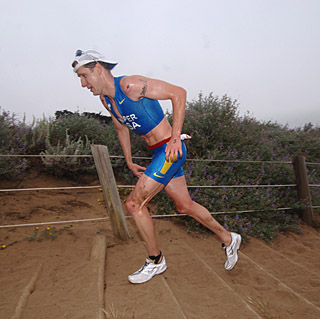
ST: While it is not the Olympics or a World Championship, this race still sets a standard of excellence.
Hunter: Escape is a classic race, one of three or four in the world everybody knows well. I won it in my best year in 2005 and finished 4th the next year. I did not race in 2007 due to injury and 2008 due to Olympics and in 2009 because I was racing at the ITU World Championship Series race in Washington DC and then Hy-Vee.
ST: How did the race go?
Hunter: My race started well. I prefer a non wetsuit swim because of my swim background but welcome wetsuits when it’s 55 degrees. I started out with Bevan Docherty, Andy Potts and Brian Fleischmann on the swim. On the bike, Bevan started to move early, then I followed. did. I came in 10 seconds behind Bevan and was even with him leaving T2. I went hard from the start of the run and passed Bevan around mile one. I got about a minute lead by the top of the sand ladder and thought the race was in my hands by then.
ST: What does the rest of 2010 hold in store?
Hunter: I am really looking forward to Hy-Vee. I love that race, [my wife] Val is due [to give birth] June 28th, Hy-Vee is June 13th, so it should work out. I think this will be a good year for me. I want to be racing consistently 10 times a year and always be in the mix. I won a lot in 2005 and half of 2006 and I was on top of the world and going strong. But when you get an injury such as I had starting 2007, it can put you off the radar screen a while.
ST: What are you aiming for this year?
Hunter: Specifically I want to be competitive for the WC Series. The thing is, the sport does not stand still. Gomez runs better, Brownlee runs better and anyone wishing to contend must be better than when I was at my peak in 2005 and 2006. I am older now, but I do believe I can run with them. But I must have uninterrupted healthy training blocks. This year I plan to race 10 times.
ST: Given the injuries what will be different in your approach to this season?
Hunter: I understand I need to maintain what I call my pre-hab routine to prevent injury from recurring. If I feel a twinge, I know what to do to ward it off. I plan to race London in 2012 and I believe I can be on the podium.
ST: Just when did your injury come around?
Hunter: I started to come around in December of 2009 and January this year. I had a few weeks of pain free training and the eventually started to come around. I took a slight calculated risk to run the Disney half marathon in January I would have shut it down if the pain had come back. But I was exhilarated with 1:09 finish. Very encouraging. Still, it didn’t come around completely until March when I started to be able to do the length and intensity of workouts I needed to compete at the WCS level. .
ST: How important was the encouragement you got from your family and friends?
Hunter: The support I got from friends and relatives was very important to getting back. A few times it was tough. Doubts crept in and frustrations set in. I finished 5th at Washington DC last June but it wasn’t a definitive sign I was near the top of the game.
ST: You worked hard to overcome the SI joint injury – to make the Olympics. But then you got another injury and had to cope with that. Tell us the history of your injuries.
Hunter: From January of 2007 to February 2008, I was hurting in the SI joint. Then, during the Olympic Trials period, I had a sports hernia. After consulting with my doctors, I decided not to get the hernia operation until after the Olympics in 2008. The operation was to put a mesh pad in there to place a boundary between the muscle and intestine. They told me with surgery it was invasive. It had developed a lot of scar tissue and so even as an outpatient there would be a lot of recovery and I’d have to take two weeks off and come back gradually. In fact I would not be able to have the hernia surgery in the 2008 season with trials and Tuscaloosa and Hy Vee.
ST: What did you do to fight the pain?
Hunter: I took some injections with cortisone like substance. Had to get a Therapeutic Use Exemption (TUE) with a doctor to inform WADA and USADA what it was for. I was able to get some cortisone injections into the hernia to calm down the pain dramatically. It allowed me to perform for 2 months pain free. I got one round about 3 weeks before Hy Vee where I made the final spot on the team at Hy-Vee. Then I got another one before the Olympics. The shots enabled me to race Hy Vee and the Olympics with no pain or discomfort.
ST: Did that cure it?
Hunter: Those shots made for a temporary solution but they did not allow the best form of sustained training blocks. The drugs calmed down the inflammation, and it was worth it because it got me through to make the team and take 7th place at Olympics at Beijing. That was as good as a medal for me. I did not think I would at all be able to finish that high and I was thrilled.
ST: You had similar numerical results in the 2004 and 2008 Olympics, but I suspect you had different reactions.
Hunter: By contrast, when I finished 9th in Athens, I was crushed. My whole world was involved in the sport of triathlon. I was ranked 5th in the world. I was 28 years old, at my peak and the upswing of my career, So when I got 9th at Athens it was very very disappointing. Between 2004 and 2008, there were only two places different. But coming into Beijing, I decided to enjoy the moment, the process, relive the Games from a kid’s point of view and lower my expectations. No one counted on me. It got me ready just in time for the Olympics and considering the journey I had been on, I felt good about my 7th place finish.
ST: When did the SI joint injury recur?
Hunter: I felt a sharp pain at every step once again starting around March of 2009. I taken care of the hernia but here comes the SI joint again. To have to constantly deal with something like that for three years was very frustrating. I did not want to lose another season, so I tried to get through and did the Oklahoma Pan Am Championships [where he was second to Matt Reed by one second] and the first ever World Championship Series event Washington DC [where he was 5th].
Given the circumstances, it was a great finish for me. But I don’t think it proved I was at the top of my game. In fact five guys – Potts, Brownlee, Maik Petzold and I made a break on the swim and we put two minutes on the field starting the bike. After that, I needed to hurry because there was a freight train of great runners coming – Frodeno and Shoemaker and Will Clarke. I was in a good amount of pain — enough to know I would hurt myself the following weekend. I tried to get through Hy Vee but that was it. I knew I could not keep on doing short term fixes.
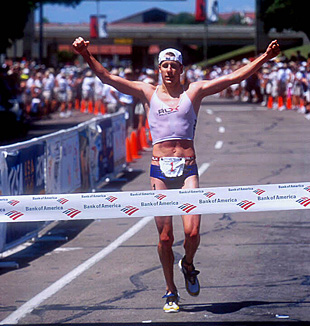
ST: So it was reset and time to develop Hunter Kemper 2.0?
Hunter: It was back to the drawing board and do what I need to do to further my career and no longer try to meet immediate commitments. It would not do any good to go on a race by race basis. I had to sit down with everyone who cares about me at USOC and my coach George Dallam and come up with a game plan. I decided not to race again until I was healthy. We all came up with rehab plan where I would swim one day bike the next, and not worry about those two sports which were not so painful to do. I would wait until I was healthy and not hurting before I ran again. In the past as an athlete, I was very good at doing training while I was rehabbing.
ST: What did your rehab consist of?
Hunter: Rehab for me was something I had to come to grips with. I did not train at first. So I started a lot of rubber band work with cords and I realized my right glute was turned off. It was like a light switch had been turned off. I was in a great deal of pain in my glute area and the base of the bone to right side was in a lot of pain. I had difficulty turning the glute light switch on and was missing most of my horsepower. When your glutes do their job, it takes the pain off my limited stride.
ST: What were the details of the injury?
Hunter: I think that joint got a little bit of an arthritic. It was the SI joint on the right side due to wear and tear. Ultimately it can be attributed to leg length discrepancy. Everybody has it to some degree. But mine was more noticeable. My right leg is significantly shorter than my left. The further I went into my career, it felt like stepping in a mini hole for thousands of steps. Because of that, it created a bone spur at the base of my SI joint (sacroiliac joint). There was no cushion to the point where the muscles could not be activated in the right way and wake up and fire at the same time. Ultimate solution was, at that point, to stay on top of it, be mindful of the condition.
ST: Did you get immediate results?
Hunter: The process took longer than I wanted. By July I thought maybe I’d be back for some late season races in October when I was feeling better. But as Fall approached, I thought why rush it to do a few non drafting races?
Ultimately I want to be on the podium at the Olympic Games. Which is difficult when you are healthy, let alone when you’re hurt. Better to wait I was healthy and then work out how to run better than ever.
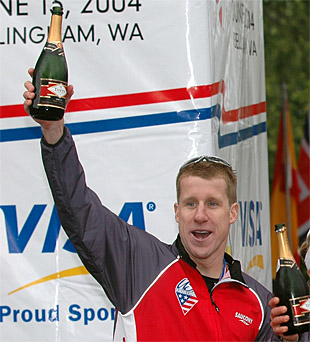
ST: During this past 9 months, people sort of forgot about you.
Hunter: Some people said I was through. I know I am not. I have more good years left in me. Maybe my best. But I was very discouraged after Hy Vee last year where I finished in the 40s.
ST: What do you do to keep that old injury at bay?
Hunter: I work with the bosu ball and I work a lot with iso bands. You put one band on a post and another on ankle and do different exercises to activate the glute and get it to fire. The band and ball work helps and so does work to strengthen your core muscle in the lower abdomen to stay rock solid, front and back.
ST: Do you really think you can step in and battle with Alistair Brownlee and Javier Gomez and Jan Frodeno now?
Hunter: It’s coming. I feel Hy Vee will be one more step and then World Cup races on run course at Hamburg and the World Championship Series finale at Hungary. I want to mix it up with those guys. This year I finished 10th at the opening WCS race in Sydney, just 40 seconds off the winner. That was a pretty solid finish with limited training. Later on it’ll be great to race those guys, When I get to Madrid that will be the kickoff for Olympics points on June 1 — the start of the next quad for the Olympics and all that is an exciting prospect.
ST: You not only have to catch Alistair Brownlee, you have to deal with American men who are coming on strong.
Hunter: Matt Chrabot, Ethan Brown and Kevin Collington are all well into the pipeline of top contenders. But at the end of the Olympic chase, I expect to see the old guys going hard. Jarrod Shoemaker leads the way now, and Andy Potts is right beside him.


